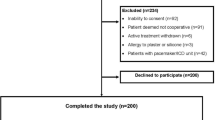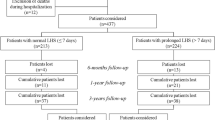Abstract
Acute exacerbations of chronic obstructive pulmonary disease (AECOPD) may rapidly require intensive care treatment. Evaluation of vital signs is necessary to detect physiological abnormalities (micro events), but patients may deteriorate between measurements. We aimed to assess if continuous monitoring of vital signs in patients admitted with AECOPD detects micro events more often than routine ward rounds. In this observational pilot study (NCT03467815), 30 adult patients admitted with AECOPD were included. Patients were continuously monitored with peripheral oxygen saturation (SpO2), heart rate, and respiratory rate during the first 4 days after admission. Hypoxaemic events were defined as decreased SpO2 for at least 60 s. Non-invasive blood pressure was also measured every 15–60 min. Clinical ward staff measured vital signs as part of Early Warning Score (EWS). Data were analysed using Fisher’s exact test or Wilcoxon rank sum test. Continuous monitoring detected episodes of SpO2 < 92% in 97% versus 43% detected by conventional EWS (p < 0.0001). Events of SpO2 < 88% was detected in 90% with continuous monitoring compared with 13% with EWS (p < 0.0001). Sixty-three percent of patients had episodes of SpO2 < 80% recorded by continuous monitoring and 17% had events lasting longer than 10 min. No events of SpO2 < 80% was detected by EWS. Micro events of tachycardia, tachypnoea, and bradypnoea were also more frequently detected by continuous monitoring (p < 0.02 for all). Moderate and severe episodes of desaturation and other cardiopulmonary micro events during hospitalization for AECOPD are common and most often not detected by EWS.



Similar content being viewed by others
References
Global Health Estimates 2016: deaths by cause, age, sex, by country and by region, 2000–2016. Geneva: World Health Organization; 2018. http://www.who.int/mediacentre/factsheets/fs310/en/. Accessed 22 Sep 2017.
Groenewegen KH, Schols AM, Wouters EFM. Mortality and mortality-related factors after hospitalization for acute exacerbation of COPD. Chest. 2003;124:459–67.
Eriksen N, Vestbo J. Management and survival of patients admitted with an exacerbation of COPD: comparison of two Danish patient cohorts. Clin Respir J. 2010;4:208–14.
Connors AF, Dawson NV, Thomas C, Harrell FE, Desbiens N, Fulkerson WJ, et al. Outcomes following acute exacerbation of severe chronic obstructive lung disease. The SUPPORT investigators (Study to Understand Prognoses and Preferences for Outcomes and Risks of Treatments). Am J Respir Crit Care Med. 1996;154(4 Pt 1):959–67. https://doi.org/10.1164/ajrccm.154.4.8887592.
Almagro P, Calbo E, De Echagüen AO, Barreiro B, Quintana S, Heredia JL, et al. Mortality after hospitalization for COPD. Chest. 2002;121:1441–8.
Petersen JA. Early warning score challenges and opportunities in the care of deteriorating patients. Dan Med J. 2018;65:B5439.
Royal College of Physicians. National Early Warning Score (NEWS): standardising the assessment of acute illness severity in the NHS. Report of a working party. London: RCP; 2012. http://www.rcplondon.ac.uk/sites/default/files/documents/national-early-warning-score-standardising-assessment-acute-illness-severity-nhs.pdf.
O’Driscoll BR, Howard LS, Davison AG, British Thoracic Society R, Forni LG, Roderick PJ. BTS guideline for emergency oxygen use in adult patients. Thorax. 2008;63(Suppl 6):vi1–68. https://doi.org/10.1136/thx.2008.102947.
Magalang UJ, Dmochowski J, Veeramachaneni S, Draw A, Mador MJ, El-Solh A, et al. Prediction of the apnea–hypopnea index from overnight pulse oximetry. Chest. 2003;124:1694–701. https://doi.org/10.1378/chest.124.5.1694.
Vallance D, Bonnici T, Tarassenko L, Charlton P, Orphanidou C, Clifton D. Signal quality indices for the electrocardiogram and photoplethysmogram: derivation and applications to wireless monitoring. IEEE J Biomed Heal Inform. 2014;19:1.
Buist M, Bernard S, Nguyen TV, Moore G, Anderson J. Association between clinically abnormal observations and subsequent in-hospital mortality: a prospective study. Resuscitation. 2004;62:137–41.
Kause J, Smith G, Prytherch D, Parr M, Flabouris A, Hillman K, et al. A comparison of antecedents to cardiac arrests, deaths and emergency intensive care admissions in Australia and New Zealand, and the United Kingdom: the ACADEMIA study. Resuscitation. 2004;62:275–82. https://doi.org/10.1016/j.resuscitation.2004.05.016.
Hodgetts TJ, Kenward G, Vlachonikolis IG, Payne S, Castle N. The identification of risk factors for cardiac arrest and formulation of activation criteria to alert a medical emergency team. Resuscitation. 2002;54:125–131. http://www.ncbi.nlm.nih.gov/pubmed/12161291. Accessed 21 Jan 2019.
Calzavacca P, Licari E, Tee A, Egi M, Haase M, Haase-Fielitz A, et al. A prospective study of factors influencing the outcome of patients after a medical emergency team review. Intensive Care Med. 2008;34:2112–6. https://doi.org/10.1007/s00134-008-1229-y.
Smith MEB, Chiovaro JC, O’Neil M, Kansagara D, Quiñones AR, Freeman M, et al. Early warning system scores for clinical deterioration in hospitalized patients: a systematic review. Ann Am Thorac Soc. 2014;11:1454–65. https://doi.org/10.1513/AnnalsATS.201403-102OC.
Petersen JA, Mackel R, Antonsen K, Rasmussen LS. Serious adverse events in a hospital using early warning score: what went wrong? Resuscitation. 2014;85:1699–703. https://doi.org/10.1016/j.resuscitation.2014.08.037.
Kellett J, Sebat F. Make vital signs great again: a call for action. Eur J Intern Med. 2017;45:13–9.
Pedersen NE, Rasmussen LS, Petersen JA, Gerds TA, Østergaard D, Lippert A. A critical assessment of early warning score records in 168,000 patients. J Clin Monit Comput. 2018;32:109–16.
Clifton DA, Clifton L, Sandu DM, Smith GB, Tarassenko L, Vollam SA, et al. “Errors” and omissions in paper-based early warning scores: the association with changes in vital signs-a database analysis. BMJ Open. 2015;5:1–7.
Kellett J, Woodworth S, Wang F, Huang W. Changes and their prognostic implications in the abbreviated Vitalpac™ early warning score (ViEWS) after admission to hospital of 18,853 acutely ill medical patients. Resuscitation. 2013;84:13–20. https://doi.org/10.1016/j.resuscitation.2012.08.331.
Petersen JA, Rasmussen LS, Rydahl-Hansen S. Barriers and facilitating factors related to use of early warning score among acute care nurses: a qualitative study. BMC Emerg Med. 2017;17:36. https://doi.org/10.1186/s12873-017-0147-0.
O’Driscoll BR, Bakerly ND, Murphy P, Decalmer S, Kane B, Nasir AA, et al. Concerns regarding the design of the bedside monitoring chart for use with the NEWS (National Early Warning System). Clin Med. 2013;13:319–20. https://doi.org/10.7861/clinmedicine.13-3-319.
Eccles SR, Subbe C, Hancock D, Thomson N. CREWS: improving specificity whilst maintaining sensitivity of the National Early Warning Score in patients with chronic hypoxaemia. Resuscitation. 2014;85:109–11. https://doi.org/10.1016/j.resuscitation.2013.08.277.
Jeffs E, Vollam S, Young JD, Horsington L, Lynch B, Watkinson PJ. Wearable monitors for patients following discharge from an intensive care unit: practical lessons learnt from an observational study. J Adv Nurs. 2016;72:1851–62.
Duus CL, Aasvang EK, Olsen RM, Sørensen HBD, Jørgensen LN, Achiam MP, et al. Continuous vital sign monitoring after major abdominal surgery: quantification of micro events. Acta Anaesthesiol Scand. 2018;62:1200–8.
Clifton L, Clifton DA, Pimentel MAF, Watkinson PJ, Tarassenko L. Predictive monitoring of mobile patients by combining clinical observations with data from wearable sensors. IEEE J Biomed Heal inform. 2014;18:722–30. https://doi.org/10.1109/JBHI.2013.2293059.
Chan ED, Chan MM, Chan MM. Pulse oximetry: understanding its basic principles facilitates appreciation of its limitations. Respir Med. 2013;107:789–99. https://doi.org/10.1016/j.rmed.2013.02.004.
Haahr-Raunkjær C, Meyhoff CS, Sørensen HBD, Olsen RM, Aasvang EK. Technological aided assessment of the acutely ill patient: the case of postoperative complications. Eur J Intern Med. 2017;45:41–5.
Turan A, Chang C, Cohen B, Saasouh W, Yang D, et al. Incidence, severity, and detection of blood pressure perturbations after abdominal surgery: a prospective blinded observational study. Anesthesiology. 2019;130:550–9.
Bowton DL, Scuderi PE, Haponik EF. The incidence and effect on outcome of hypoxemia in hospitalized medical patients. Am J Med. 1994;97:38–46.
Brekke IJ, Puntervoll LH, Pedersen PB, Kellett J, Brabrand M. The value of vital sign trends in predicting and monitoring clinical deterioration: a systematic review. PLoS ONE. 2019;14:e0210875.
Churpek MM, Adhikari R, Edelson DP. The value of vital sign trends for detecting clinical deterioration on the wards. Resuscitation. 2016;102:1–5. https://doi.org/10.1016/j.resuscitation.2016.02.005.
Steinhubl SR, Feye D, Levine AC, Conkright C, Wegerich SW, Conkright G. Validation of a portable, deployable system for continuous vital sign monitoring using a multiparametric wearable sensor and personalised analytics in an Ebola treatment centre. BMJ Glob Health. 2016;1:e000070. https://doi.org/10.1136/bmjgh-2016-000070.
Churpek MM, Yuen TC, Winslow C, Meltzer DO, Kattan MW, Edelson DP. Multicenter comparison of machine learning methods and conventional regression for predicting clinical deterioration on the wards. Crit Care Med. 2016;44:368–74.
Lundberg SM, Nair B, Vavilala MS, Horibe M, Eisses MJ, Adams T, et al. Explainable machine-learning predictions for the prevention of hypoxaemia during surgery. Nat Biomed Eng. 2018;2:749–60. https://doi.org/10.1038/s41551-018-0304-0.
Tarassenko L, Hann A, Young D. Integrated monitoring and analysis for early warning of patient deterioration. Br J Anaesth. 2006;97:64–8. https://doi.org/10.1093/bja/ael113.
Downey CL, Chapman S, Randell R, Brown JM, Jayne DG. The impact of continuous versus intermittent vital signs monitoring in hospitals: a systematic review and narrative synthesis. Int J Nurs Stud. 2018;84:19–27.
Funding
M. E.: Received funding from Copenhagen Center for Health Technology (CACHET). The WARD-Project Group received funding from The Danish Cancer Society, The A. P. Møller Foundation, and Innovation Fund Denmark. Other authors: Departmental funding only.
Author information
Authors and Affiliations
Consortia
Corresponding author
Ethics declarations
Conflict of interest
M. E. reports departmental research funding from Merck Sharp & Dome Corp. outside the submitted work. C S. M. reports direct and indirect research funding from Ferring Pharmaceuticals, Merck Sharp & Dohme Corp., and Boehringer Ingelheim outside the submitted work. Other authors report none.
Ethical approval
All procedures performed in studies involving human participants were in accordance with the ethical standards of the institutional and/or national research committee and with the 1964 Helsinki declaration and its later amendments or comparable ethical standards.
Informed consent
Informed consent was obtained from all individual participants included in the study.
Additional information
Publisher's Note
Springer Nature remains neutral with regard to jurisdictional claims in published maps and institutional affiliations.
Rights and permissions
About this article
Cite this article
Elvekjaer, M., Aasvang, E.K., Olsen, R.M. et al. Physiological abnormalities in patients admitted with acute exacerbation of COPD: an observational study with continuous monitoring. J Clin Monit Comput 34, 1051–1060 (2020). https://doi.org/10.1007/s10877-019-00415-8
Received:
Accepted:
Published:
Issue Date:
DOI: https://doi.org/10.1007/s10877-019-00415-8




